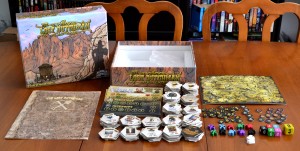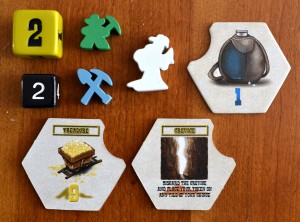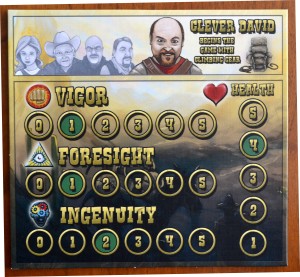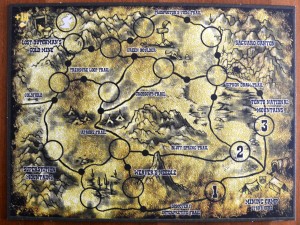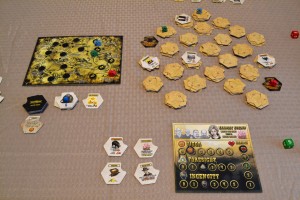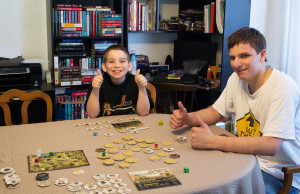No one really knows where the legendary Lost Dutchman Gold Mine is, but that won’t stop people from looking for it. There’s still some speculation as to whether or not the legend is actually true, but those who do believe estimate the mine to lie somewhere in the southwestern parts of the United States. The mine itself is named after one Jacob Waltz (a German immigrant) who reportedly found the mine but kept its location secret. In, “The Lost Dutchman”, players will be taking on the role of prospectors in search of this legend. Not only will they be competing against one another, but they’ll be braving the elements and trying to overcome various dangers. Before we begin checking out the game in further detail, I’d like to thank the folks at Game Salute for providing me with a free review copy.
Components
Treasure Map, Prospectors, & Challenge Tokens – Players will be using their wooden prospector meeples to track their progress on the treasure map. The treasure map is a separate board that is made up of multiple routes, which players will be traversing in an attempt to get to the Lost Dutchman’s treasure. Challenge tokens are placed on the treasure map and provide players with the requirements necessary to travel along a particular route. In order to meet these challenges and advance along these routes, players will need to defeat creatures and overcome disasters.
Hexagon Tiles & Mining Tokens – The main playing area (the mountain) consists of stacked hexagon tiles that contain hazards, treasure, items, and more. Players will be moving around this mountain and digging (revealing hexagons) with their mining tokens. Some hexagon tiles are placed off to the side and serve a different purpose, but I’ll get into that in a bit.
Player Event Tiles – These tiles are their own, separate face down stack that determines how players interact with one another should they encompass the same space on the mountain.
Canteen Tiles – These tiles serve as a game timer of sorts, representing the amount of water available to the players in the game. Certain hexagon tiles on the mountain will cause the canteen level to drop, bringing the game closer to its end.
Lost Dutchman Ghost Tile & Meeple – The Dutchman’s ghost serves to tie players up in various ways. The meeple can be placed on a player’s unburied treasure, for example, to prevent them from scoring on it at the end of the game. The tile serves to remind players of the ghost’s strength in combat.
Player Boards & Attribute Tokens – Each player will be represented by a unique character, each having their own stat sheet. Players will be using the player board and attribute tokens to track various stats as they progress throughout the game.
Dice – The game comes with five action dice (one for each player) and one custom d6 movement die.
Setup & Gameplay
Rather than waste your time with a long paragraph on how to set up the game, I felt it easier to simply include a link to a developer video that explains the process in detail.
On a player’s turn, they’ll roll the movement die and advance their mining token around the mountain. When players land on a space, they must flip the tile over (if the tile is face down) and encounter whatever happens to be on that tile. Some examples of the tiles players will reveal are as follows:
Treasure – Treasure tiles have a value associated with them. The higher the value, the more valuable the treasure. Players will be trying to collect these in order to score points at the end of the game. Treasure is placed face up in front of the owner, meaning that it is open game for anyone who may want to steal it. Players can bury their treasure tiles (flip them face down) through various game events in order to protect them.
Creatures – Creature tiles contain a win/loss chart along with the conditions necessary for the player to defeat it in battle. The tile will also specify what attribute(s) the player will be using to modify their die roll. If the die roll plus the attribute value is greater than the creature’s value, the player will defeat and keep the creature tile. Creature tiles reward players with immediate and endgame rewards, as well as allow players to move up the treasure map track. This is assuming, of course, you are able to defeat them.
Disaster – Disaster tiles work similarly to creature tiles in that you’ll be rolling in an attempt to defeat them. Like the creature tiles, disaster tiles contain a win/loss chart along with the requirements necessary for the player to overcome them. Defeating disaster tiles awards the player appropriately, both immediately and during endgame scoring.
Water Level Drops – This tile signals players to reduce the value of the shared canteen level by one. When the water runs out, the game ends and players add up their treasure points appropriately. This is one of the two ways the game can come to an end.
Bandits – Bandits allow players the opportunity to fight other players and steal their treasure, usually by way of die rolls. It’s important to remember that buried treasure is safe from this action.
Treasure Hunters & Special Items – These are rare and special tiles that give players special abilities throughout the game. One of them, for example, doubles the points of a treasure tile at the end of the game…pretty powerful!
To sum everything up, players will be moving their mining tokens around the mountain, trying to collect and bury treasure. While doing this, players will also be aiming to advance their prospector meeple along the treasure map in an attempt to reach the Lost Dutchman’s treasure. The game ends when one person manages to do so, or when the water level runs out. When either endgame condition has been satisfied, the treasure points are tallied and the person with the most, wins!
The above doesn’t cover all of the rules found in the manual, but should give you an idea as to how the game is played. For more information, please check out the links at the end of this article. There’s also an excellent gameplay tutorial, here:
The Review
The components do an excellent job in conveying the appropriate theme. I also liked how each character had their own stat sheet, giving players a way to separate themselves from the others. The box insert functioned well and the baggies that came with the game held all of the pieces without a problem. It’s important to note that the game originally featured cards in place of hexagon tiles, so those with a prototype copy may see some slight differences with this version. I’ll get to my thoughts on the hexagon tiles in a bit. Some of the components can be used to play a short, separate game called “Goldfield Gully”, which I thought was a nice bonus. It’s a press your luck / free-for-all kind of game that tasks players with earning the most gold over ten rounds. If you don’t have enough time to play the full game, “Goldfield Gully” is a great alternative as it can be completed in under a half hour.
One of my favorite aspects of the game is how the characters improve over time. What I didn’t mention in the gameplay section was that characters have so much life alloted to them. If you can keep them alive, they’ll gain attributes points as they overcome various obstacles. If you happen to run out of health however, your attributes are reset and you lose some of your treasure. This mechanic made me care about my character enough to want to keep him alive. The longer you can keep your character afloat, the better chance you’ll have during your encounters as your attributes are factored in along with the die roll. When facing the Dutchman at his mine, you’ll need all of the attribute points you can get in order to beat him.
After playing the game a few times with the kids, I’ve come to conclude that it’s a bit more luck based than strategy based. For one thing, you never know what tile you’re going to get when you land on one. All of the movement and combat in the game is done via die rolls, setting players up for streaks of good or bad luck. It’s possible to play the game as well as you can, but still get knocked off due to some unlucky die rolls. On our next run, I might try making creature encounters optional, just to see how that affects the balance of the game. This would introduce a risk element while at the same time, giving players more control over their destiny. Don’t get me wrong, there is strategy involved with this game, but it often takes a back seat when you require good die rolls (in combat) to advance your character along the treasure map. Losing combat rolls can really set your character back, especially if you are forced to lose attribute points.
I felt an odd disconnect between the treasure map and the mountain in how they relate to one another. While the treasure map tracks the true progress of characters, it’s possible to mine the same spot on the mountain regardless of where you are on the treasure map. It was easier to just to accept the disconnect and think of the mountain as an event pool rather than a location. The kids were a bit confused by this layout as well, but it didn’t stop us from playing the game in any way. Sometimes it’s easier to just accept something that doesn’t make sense and move on.
My biggest gripe with the game was how difficult it was to pick up the hexagon tiles in order to flip them over. Even though the tiles have grooves to assist in the flipping process, it’s difficult to do so without knocking some of the other tiles around because of their size. My OCD kicked in every time someone messed up the board, causing me to have to stop and restack the hexagon tiles neatly. On our second game, we opted to space the hexagon stacks farther apart from each other, rather than group them up tightly. I suppose you could get creative and use Nerf darts to pick them up as well. The tiles are nice, but I honestly would have prefered the cards as they would have been easier for me to pick up and handle. I would also imagine that the text size on the cards would have been a bit larger…at present, I have to squint to see the small text written on the hexagon tiles.
When stepping back to look at the big picture, I found “The Lost Dutchman” to be a fairly good game. While some of the game’s features turn me off, there was enough here to where the kids and I had an enjoyable experience. Play was fast and unpredictable, preventing any one player from becoming a run away leader…at least, on purpose. Vinnie (12) didn’t seem to mind the luck factor as much as I did, even though he became visibly frustrated at one point during a string of unlucky tile reveals and die rolls. Despite that occurrence, he indicated that he had a good time and liked the game overall. As a casual family game where competition doesn’t matter, “The Lost Dutchman” fits the bill nicely. Those who prefer to be in control of their play experience through and through may have a hard time with the die rolls and random tile events, but it’s certainly worth checking out anyway. The current price of $39.99 (as of 6/17/13) isn’t a bad one, though if you’re living pay to pay like myself, you may want to do your research first as it won’t appeal to everyone. My recommendation is to check out the links above and below before making any impulse decisions.
Final Verdict: 7/10
—
You can learn more about and purchase “The Lost Dutchman” by visiting the following websites:
http://www.kickstarter.com/projects/crashgames/legend-of-the-lost-dutchman
http://boardgamegeek.com/boardgame/121122/the-lost-dutchman

